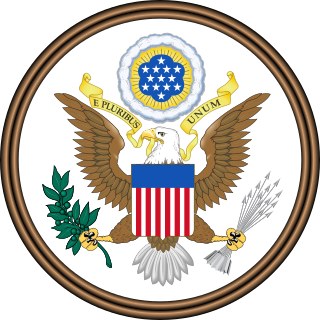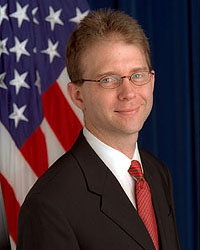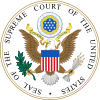
The United States Food and Drug Administration is a federal agency of the Department of Health and Human Services. The FDA is responsible for protecting and promoting public health through the control and supervision of food safety, tobacco products, caffeine products, dietary supplements, prescription and over-the-counter pharmaceutical drugs (medications), vaccines, biopharmaceuticals, blood transfusions, medical devices, electromagnetic radiation emitting devices (ERED), cosmetics, animal foods & feed and veterinary products.

Stevens–Johnson syndrome (SJS) is a type of severe skin reaction. Together with toxic epidermal necrolysis (TEN) and Stevens–Johnson/toxic epidermal necrolysis (SJS/TEN), it forms a spectrum of disease, with SJS being less severe. Erythema multiforme (EM) is generally considered a separate condition. Early symptoms of SJS include fever and flu-like symptoms. A few days later, the skin begins to blister and peel, forming painful raw areas. Mucous membranes, such as the mouth, are also typically involved. Complications include dehydration, sepsis, pneumonia and multiple organ failure.

A generic drug is a pharmaceutical drug that contains the same chemical substance as a drug that was originally protected by chemical patents. Generic drugs are allowed for sale after the patents on the original drugs expire. Because the active chemical substance is the same, the medical profile of generics is equivalent in performance compared to their performance at the time when they were patented drugs. A generic drug has the same active pharmaceutical ingredient (API) as the original, but it may differ in some characteristics such as the manufacturing process, formulation, excipients, color, taste, and packaging.

The Food and Drug Administration's (FDA) New Drug Application (NDA) is the vehicle in the United States through which drug sponsors formally propose that the FDA approve a new pharmaceutical for sale and marketing. Some 30% or less of initial drug candidates proceed through the entire multi-year process of drug development, concluding with an approved NDA, if successful.

Piroxicam is a nonsteroidal anti-inflammatory drug (NSAID) of the oxicam class used to relieve the symptoms of painful inflammatory conditions like arthritis. Piroxicam works by preventing the production of endogenous prostaglandins which are involved in the mediation of pain, stiffness, tenderness and swelling. The medicine is available as capsules, tablets and as a prescription-free gel 0.5%. It is also available in a betadex formulation, which allows a more rapid absorption of piroxicam from the digestive tract. Piroxicam is one of the few NSAIDs that can be given parenteral routes.

Triamterene is a potassium-sparing diuretic often used in combination with thiazide diuretics for the treatment of high blood pressure or swelling. The combination with hydrochlorothiazide, is known as hydrochlorothiazide/triamterene.

Erlotinib, sold under the brand name Tarceva among others, is a medication used to treat non-small cell lung cancer (NSCLC) and pancreatic cancer. Specifically it is used for NSCLC with mutations in the epidermal growth factor receptor (EGFR) — either an exon 19 deletion (del19) or exon 21 (L858R) substitution mutation — which has spread to other parts of the body. It is taken by mouth.

Moxifloxacin is an antibiotic, used to treat bacterial infections, including pneumonia, conjunctivitis, endocarditis, tuberculosis, and sinusitis. It can be given by mouth, by injection into a vein, and as an eye drop.

The Drug Price Competition and Patent Term Restoration Act, informally known as the Hatch-Waxman Act, is a 1984 United States federal law that established the modern system of generic drug regulation in the United States. The Act's two main goals are to facilitate entry of generic drugs into the market and to compensate the original drug developers for regulatory delays by the Food and Drug Administration. It is generally believed that the Act accomplished both goals: encouraging development of new medications and accelerating market entry of generics.

Sulindac is a nonsteroidal anti-inflammatory drug (NSAID) of the arylalkanoic acid class that is marketed as Clinoril. Imbaral is another name for this drug. Its name is derived from sul(finyl)+ ind(ene)+ ac(etic acid) It was patented in 1969 and approved for medical use in 1976.

Jay Lefkowitz is an American lawyer. He is a senior partner at the Kirkland & Ellis law firm, and he also served as President George W. Bush's Special Envoy for Human Rights in North Korea.
Roche Products, Inc. v. Bolar Pharmaceutical Co., 733 F.2d 858, was a court case in the United States related to the manufacturing of generic pharmaceuticals.
Evergreening is any of various legal, business, and technological strategies by which producers extend the lifetime of their patents that are about to expire in order to retain revenues from them. Often the practice includes taking out new patents, or by buying out or frustrating competitors, for longer periods of time than would normally be permissible under the law. Robin Feldman, a law professor at UC Law SF and a leading researcher in intellectual property and patents, defines evergreening as "artificially extending the life of a patent or other exclusivity by obtaining additional protections to extend the monopoly period."
Wyeth v. Levine, 555 U.S. 555 (2009), is a United States Supreme Court case holding that Federal regulatory approval of a medication does not shield the manufacturer from liability under state law.

Hydrocodone/ibuprofen (INNs), sold under the brand name Vicoprofen, is a fixed-dose combination analgesic medication used in short-term therapy to relieve severe pain. Vicoprofen combines the analgesic and antitussive properties of hydrocodone with the analgesic, anti-inflammatory, and antipyretic properties of ibuprofen. In contrast to hydrocodone/acetaminophen combination analgesics such as Vicodin, this hydrocodone/ibuprofen avoids some of the liver toxicity which may occur from acetaminophen, but still presents significant dangers in hydrocodone overdose, namely respiratory depression. Vicoprofen is supplied in a fixed dose combination tablet which contains hydrocodone bitartrate, USP 7.5 mg with ibuprofen, USP 200 mg. Additional strengths of generic Vicoprofen are now available, in combinations of 5 mg/200 mg and 10 mg/200 mg respectively.
The Food and Drug Administration is a federal agency of the United States, formed in 1930.
Reverse payment patent settlements, also known as "pay-for-delay" agreements, are a type of agreement that has been used to settle pharmaceutical patent infringement litigation, in which the company that has brought the suit agrees to pay the company it sued. That is, the patent holder pays the alleged infringer to stop its alleged infringing activity for some period of time and to stop disputing the validity of the patent. These agreements are distinct from most patent settlements, which usually involve the alleged infringer paying the patent holder.
FTC v. Actavis, Inc., 570 U.S. 136 (2013), was a United States Supreme Court decision in which the Court held that the FTC could make an antitrust challenge under the rule of reason against a so-called pay-for-delay agreement, also referred to as a reverse payment patent settlement. Such an agreement is one in which a drug patentee pays another company, ordinarily a generic drug manufacturer, to stay out of the market, thus avoiding generic competition and a challenge to patent validity. The FTC sought to establish a rule that such agreements were presumptively illegal, but the Court ruled only that the FTC could bring a case under more general antitrust principles permitting a defendant to assert justifications for its actions under the rule of reason.

A botanical drug is defined in the United States Federal Food, Drug, and Cosmetic Act as a botanical product that is marketed as diagnosing, mitigating, treating, or curing a disease; a botanical product in turn, is a finished, labeled product that contains ingredients from plants. Chemicals that are purified from plants, like paclitaxel, and highly purified products of industrial fermentation, like biopharmaceuticals, are not considered to be botanical products.

Adrenocorticotropic hormone is used as a medication and as diagnostic agent in the ACTH stimulation test.














